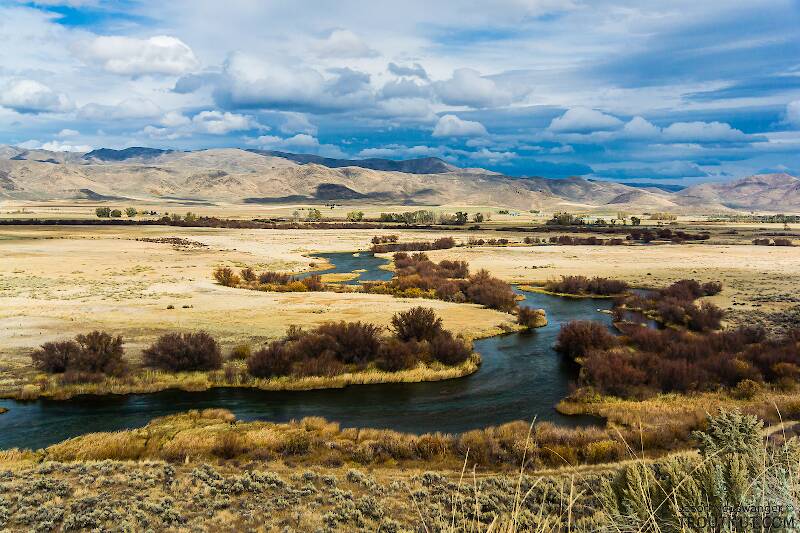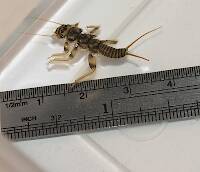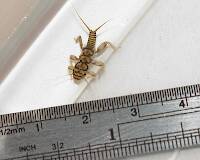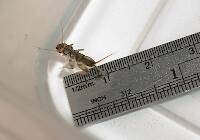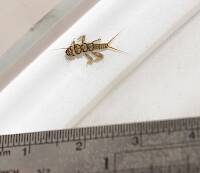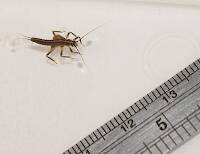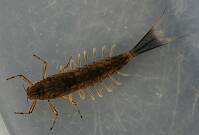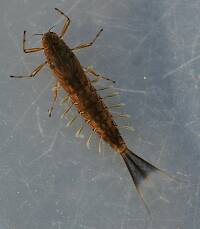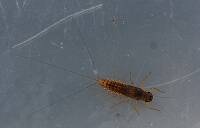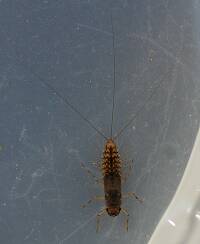
Salmonflies
Pteronarcys californica
The giant Salmonflies of the Western mountains are legendary for their proclivity to elicit consistent dry-fly action and ferocious strikes.
Featured on the forum

This specimen resembled several others of around the same size and perhaps the same species, which were pretty common in my February sample from the upper Yakima. Unfortunately, I misplaced the specimen before I could get it under a microscope for a definitive ID.

Troutnut is a project started in 2003 by salmonid ecologist Jason "Troutnut" Neuswanger to help anglers and
fly tyers unabashedly embrace the entomological side of the sport. Learn more about Troutnut or
support the project for an enhanced experience here.
DOS on Feb 28, 2009February 28th, 2009, 2:46 pm EST
Hello All,
I was wondering if there was anyone out there who was into macro photography or has experience with it, specifically photographing insects. I have recently gotten into a DSLR and I'm looking to get a macro lens. I'm wonder if the use of a macro lens is how pictures like this were achieved.
I also have a Amscope Stereo dissection microscope 2x-90x with a third ocular for a camera hook up. Anyone use one of these to photograph insects? What does your set up consist of?
and last but not least I'd like to share some of my recent insect pics from my favorite local creek. All of these pictures have been taken with a Canon PowerShot in macro mode... I have yet to break in my DSLR on any insects yet.







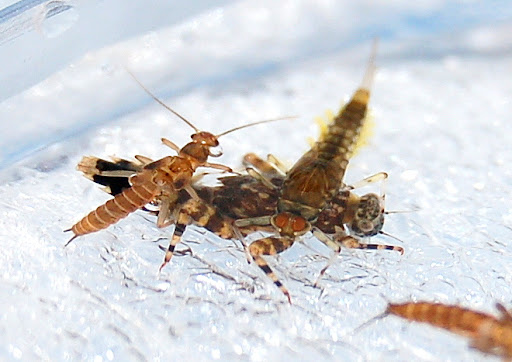
I was wondering if there was anyone out there who was into macro photography or has experience with it, specifically photographing insects. I have recently gotten into a DSLR and I'm looking to get a macro lens. I'm wonder if the use of a macro lens is how pictures like this were achieved.

I also have a Amscope Stereo dissection microscope 2x-90x with a third ocular for a camera hook up. Anyone use one of these to photograph insects? What does your set up consist of?
and last but not least I'd like to share some of my recent insect pics from my favorite local creek. All of these pictures have been taken with a Canon PowerShot in macro mode... I have yet to break in my DSLR on any insects yet.






Andrew Nisbet
Troutnut on Feb 28, 2009February 28th, 2009, 9:08 pm EST
Some nice shots there. As you can tell from this site, I am into macro photography. ;)
Most of my bug pictures are taken with a Canon 20D DSLR and two Canon macro lenses, the 100mm f/2.8 and the 65mm 1-5X, with the MT-24EX macro flash. It's a pretty expensive setup but it sure gets the job done.
I haven't done much photography through a microscope, but decent pictures can certainly be taken that way.
Most of my bug pictures are taken with a Canon 20D DSLR and two Canon macro lenses, the 100mm f/2.8 and the 65mm 1-5X, with the MT-24EX macro flash. It's a pretty expensive setup but it sure gets the job done.
I haven't done much photography through a microscope, but decent pictures can certainly be taken that way.
Jason Neuswanger, Ph.D.
Troutnut and salmonid ecologist
Troutnut and salmonid ecologist
Creno on Mar 1, 2009March 1st, 2009, 4:52 am EST
DOS - there is alot of info out there about photography via a microscope photo tube. And you should be able to easily attach your digital body to the scope with an adapter. If your camera has the ability to attach to a pc you can use the screen capture ability of many photo software programs to capture straight to the pc and use the pc monitor to see/adjust the image rather than the small camera screen.
The two major differences between a scope and a macro lens are depth and area of field. You will lose alot of both via the scope. If you can get the great photos (like many you will see on this site) of what you want via a macro lens I would use it as generally you will have a better depth of field. While I have invested my $$ in the scope approach it is really amazing what folks are doing nowadays with "hand held" digital cameras.
There are programs generally called montage programs which can create depth of field from several combined microscope photos so when you decide you really want up close photos via the scope they can be really great photos. And the technology is improving every day so you will have to check the market when you decide to take that step. As the experience increases the prices are dropping dramatically and there is very good shareware out there now.
One item that will greatly improve all your photos is to make sure the critters in liquid are completely covered with liquid. So may pictures would be so much better if that simple process to reduce reflections was followed.
The two major differences between a scope and a macro lens are depth and area of field. You will lose alot of both via the scope. If you can get the great photos (like many you will see on this site) of what you want via a macro lens I would use it as generally you will have a better depth of field. While I have invested my $$ in the scope approach it is really amazing what folks are doing nowadays with "hand held" digital cameras.
There are programs generally called montage programs which can create depth of field from several combined microscope photos so when you decide you really want up close photos via the scope they can be really great photos. And the technology is improving every day so you will have to check the market when you decide to take that step. As the experience increases the prices are dropping dramatically and there is very good shareware out there now.
One item that will greatly improve all your photos is to make sure the critters in liquid are completely covered with liquid. So may pictures would be so much better if that simple process to reduce reflections was followed.
Quick Reply
Related Discussions
Topic
Replies
Last Reply
Re: DIY Photo-Microscope with a smart cell phone, iPod Touch, iPad (aka Smart-D-Scope)
In the Photography Board by LowBudget
In the Photography Board by LowBudget
1
Apr 1, 2014
by Entoman
by Entoman
4
Mar 16, 2010
by Wiflyfisher
by Wiflyfisher
2
May 19, 2007
by Troutnut
by Troutnut
1
Sep 24, 2011
by Troutnut
by Troutnut
3
Nov 25, 2006
by Troutnut
by Troutnut

